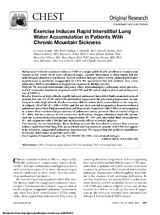Mostrar el registro sencillo del ítem
Exercise induces rapid interstitial lung water accumulation in patients with chronic mountain sickness
| dc.contributor.author | Pratali, Lorenza | |
| dc.contributor.author | Rimoldi, Stefano F | |
| dc.contributor.author | Rexhaj, Emrush | |
| dc.contributor.author | Hutter, Damian | |
| dc.contributor.author | Faita, Francesco | |
| dc.contributor.author | Salinas Salmón, Carlos E | |
| dc.contributor.author | Villena, Mercedes | |
| dc.contributor.author | Sicari, Rosa | |
| dc.contributor.author | Picano, Eugenio | |
| dc.contributor.author | Allemann, Yves | |
| dc.contributor.author | Scherrer, Urs | |
| dc.contributor.author | Sartori, Claudio | |
| dc.date.accessioned | 2016-09-27T15:02:07Z | |
| dc.date.available | 2016-09-27T15:02:07Z | |
| dc.date.issued | 2012-04-04 | |
| dc.identifier.uri | http://repositorio.umsa.bo/xmlui/handle/123456789/8044 | |
| dc.description.abstract | Background: Chronic mountain sickness (CMS) is a major public health problem in mountainous regions of the world. In its more advanced stages, exercise intolerance is often found, but the underlying mechanism is not known. Recent evidence indicates that exercise-induced pulmonary hypertension is markedly exaggerated in CMS. We speculated that this problem may cause pulmonary fluid accumulation and aggravate hypoxemia during exercise. Methods: We assessed extravascular lung water (chest ultrasonography), pulmonary artery pressure, and left ventricular function in 15 patients with CMS and 20 control subjects at rest and during exercise at 3,600 m. Results: Exercise at high altitude rapidly induced pulmonary interstitial fluid accumulation in all patients but one (14 of 15) with CMS and further aggravated the preexisting hypoxemia. In contrast, in healthy high-altitude dwellers exercise did not induce fluid accumulation in the majority of subjects (16 of 20) (P5.002 vs CMS) and did not alter arterial oxygenation. Exercise-induced pulmonary interstitial fluid accumulation and hypoxemia in patients with CMS was accompanied by a more than two times larger increase of pulmonary artery pressure than in control subjects (P,.001), but no evidence of left ventricular dysfunction. Oxygen inhalation markedly attenuated the exercise-induced pulmonary hypertension (P,.01) and interstitial fluid accumulation (P,.05) in patients with CMS but had no detectable effects in control subjects. Conclusions: To our knowledge, these findings provide the first direct evidence that exercise induces rapid interstitial lung fluid accumulation and hypoxemia in patients with CMS that appear to be related to exaggerated pulmonary hypertension. We suggest that this problem contributes to exercise intolerance in patients with CMS. | es_ES |
| dc.language.iso | en | es_ES |
| dc.publisher | CHEST | es_ES |
| dc.subject | MAL CRÓNICO DE MONTAÑA | es_ES |
| dc.subject | PULMONAR INTERSTICIAL | es_ES |
| dc.title | Exercise induces rapid interstitial lung water accumulation in patients with chronic mountain sickness | es_ES |
| dc.type | Article | es_ES |

